Supply Chain Management: Evaluating the Seven Core Principles
VerifiedAdded on 2022/12/15
|7
|2366
|281
Report
AI Summary
This report provides an in-depth analysis of the article "The Seven Principles of Supply Chain Management," which outlines key strategies for effective supply chain management. The report begins with an introduction to the article's purpose, key ideas, and significance. It then delves into the main arguments, including the methodology used (conceptual) and the lessons learned, such as the importance of customer segmentation, network customization, and aligning demand planning. The report evaluates the author's line of reasoning, assumptions, and the article's relevance in the context of modern supply chain practices. The report also highlights the challenges related to statistical data and the traditional approach. The conclusion summarizes the article's usefulness for both theory and practice, emphasizing the significance of adapting to customer needs and leveraging information technology for decision-making. It also explores the article's limitations and its implications for contemporary supply chain management.

Running Head: SUPPLY CHAIN 0
Supply Chain
Supply Chain
Paraphrase This Document
Need a fresh take? Get an instant paraphrase of this document with our AI Paraphraser
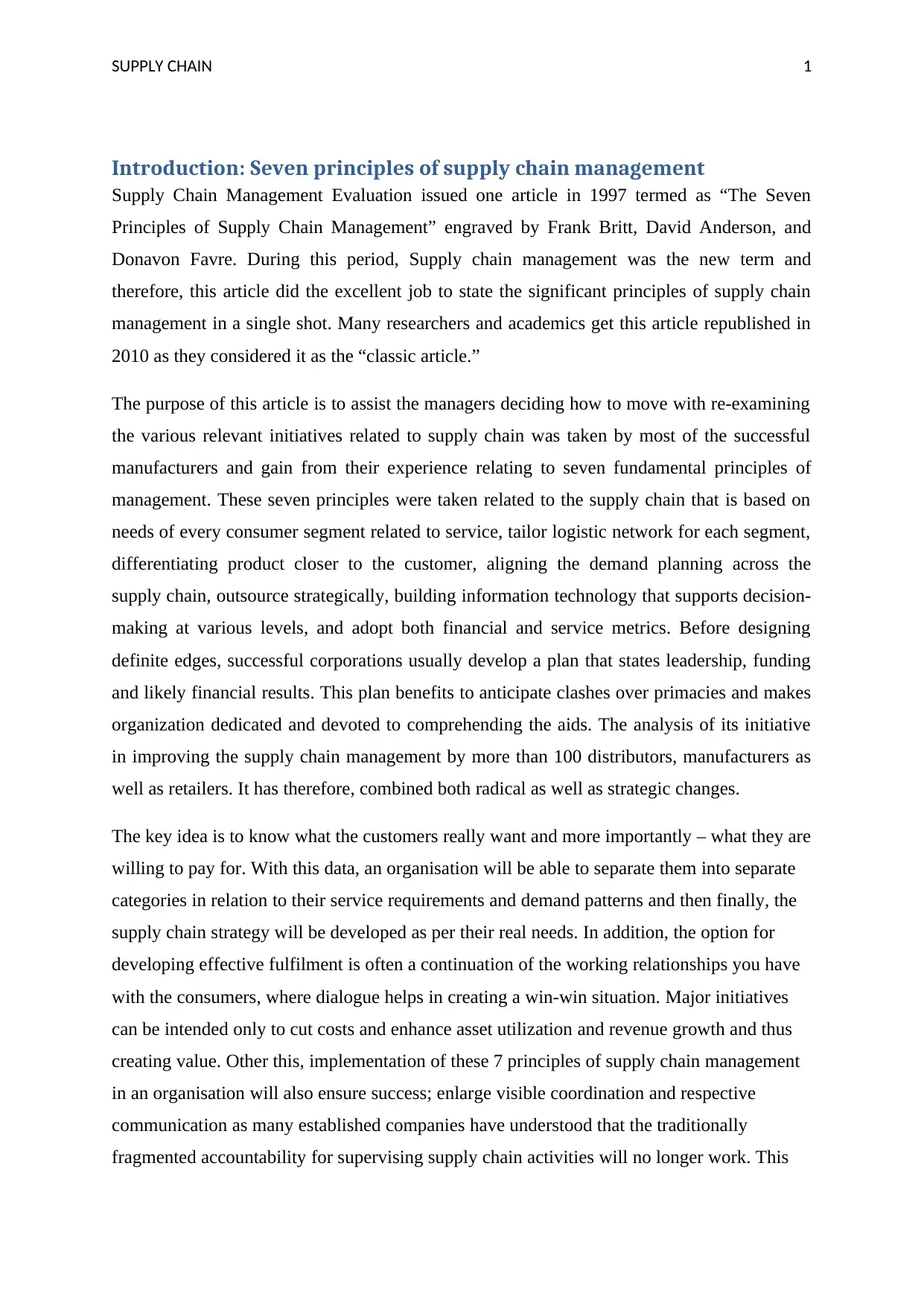
SUPPLY CHAIN 1
Introduction: Seven principles of supply chain management
Supply Chain Management Evaluation issued one article in 1997 termed as “The Seven
Principles of Supply Chain Management” engraved by Frank Britt, David Anderson, and
Donavon Favre. During this period, Supply chain management was the new term and
therefore, this article did the excellent job to state the significant principles of supply chain
management in a single shot. Many researchers and academics get this article republished in
2010 as they considered it as the “classic article.”
The purpose of this article is to assist the managers deciding how to move with re-examining
the various relevant initiatives related to supply chain was taken by most of the successful
manufacturers and gain from their experience relating to seven fundamental principles of
management. These seven principles were taken related to the supply chain that is based on
needs of every consumer segment related to service, tailor logistic network for each segment,
differentiating product closer to the customer, aligning the demand planning across the
supply chain, outsource strategically, building information technology that supports decision-
making at various levels, and adopt both financial and service metrics. Before designing
definite edges, successful corporations usually develop a plan that states leadership, funding
and likely financial results. This plan benefits to anticipate clashes over primacies and makes
organization dedicated and devoted to comprehending the aids. The analysis of its initiative
in improving the supply chain management by more than 100 distributors, manufacturers as
well as retailers. It has therefore, combined both radical as well as strategic changes.
The key idea is to know what the customers really want and more importantly – what they are
willing to pay for. With this data, an organisation will be able to separate them into separate
categories in relation to their service requirements and demand patterns and then finally, the
supply chain strategy will be developed as per their real needs. In addition, the option for
developing effective fulfilment is often a continuation of the working relationships you have
with the consumers, where dialogue helps in creating a win-win situation. Major initiatives
can be intended only to cut costs and enhance asset utilization and revenue growth and thus
creating value. Other this, implementation of these 7 principles of supply chain management
in an organisation will also ensure success; enlarge visible coordination and respective
communication as many established companies have understood that the traditionally
fragmented accountability for supervising supply chain activities will no longer work. This
Introduction: Seven principles of supply chain management
Supply Chain Management Evaluation issued one article in 1997 termed as “The Seven
Principles of Supply Chain Management” engraved by Frank Britt, David Anderson, and
Donavon Favre. During this period, Supply chain management was the new term and
therefore, this article did the excellent job to state the significant principles of supply chain
management in a single shot. Many researchers and academics get this article republished in
2010 as they considered it as the “classic article.”
The purpose of this article is to assist the managers deciding how to move with re-examining
the various relevant initiatives related to supply chain was taken by most of the successful
manufacturers and gain from their experience relating to seven fundamental principles of
management. These seven principles were taken related to the supply chain that is based on
needs of every consumer segment related to service, tailor logistic network for each segment,
differentiating product closer to the customer, aligning the demand planning across the
supply chain, outsource strategically, building information technology that supports decision-
making at various levels, and adopt both financial and service metrics. Before designing
definite edges, successful corporations usually develop a plan that states leadership, funding
and likely financial results. This plan benefits to anticipate clashes over primacies and makes
organization dedicated and devoted to comprehending the aids. The analysis of its initiative
in improving the supply chain management by more than 100 distributors, manufacturers as
well as retailers. It has therefore, combined both radical as well as strategic changes.
The key idea is to know what the customers really want and more importantly – what they are
willing to pay for. With this data, an organisation will be able to separate them into separate
categories in relation to their service requirements and demand patterns and then finally, the
supply chain strategy will be developed as per their real needs. In addition, the option for
developing effective fulfilment is often a continuation of the working relationships you have
with the consumers, where dialogue helps in creating a win-win situation. Major initiatives
can be intended only to cut costs and enhance asset utilization and revenue growth and thus
creating value. Other this, implementation of these 7 principles of supply chain management
in an organisation will also ensure success; enlarge visible coordination and respective
communication as many established companies have understood that the traditionally
fragmented accountability for supervising supply chain activities will no longer work. This
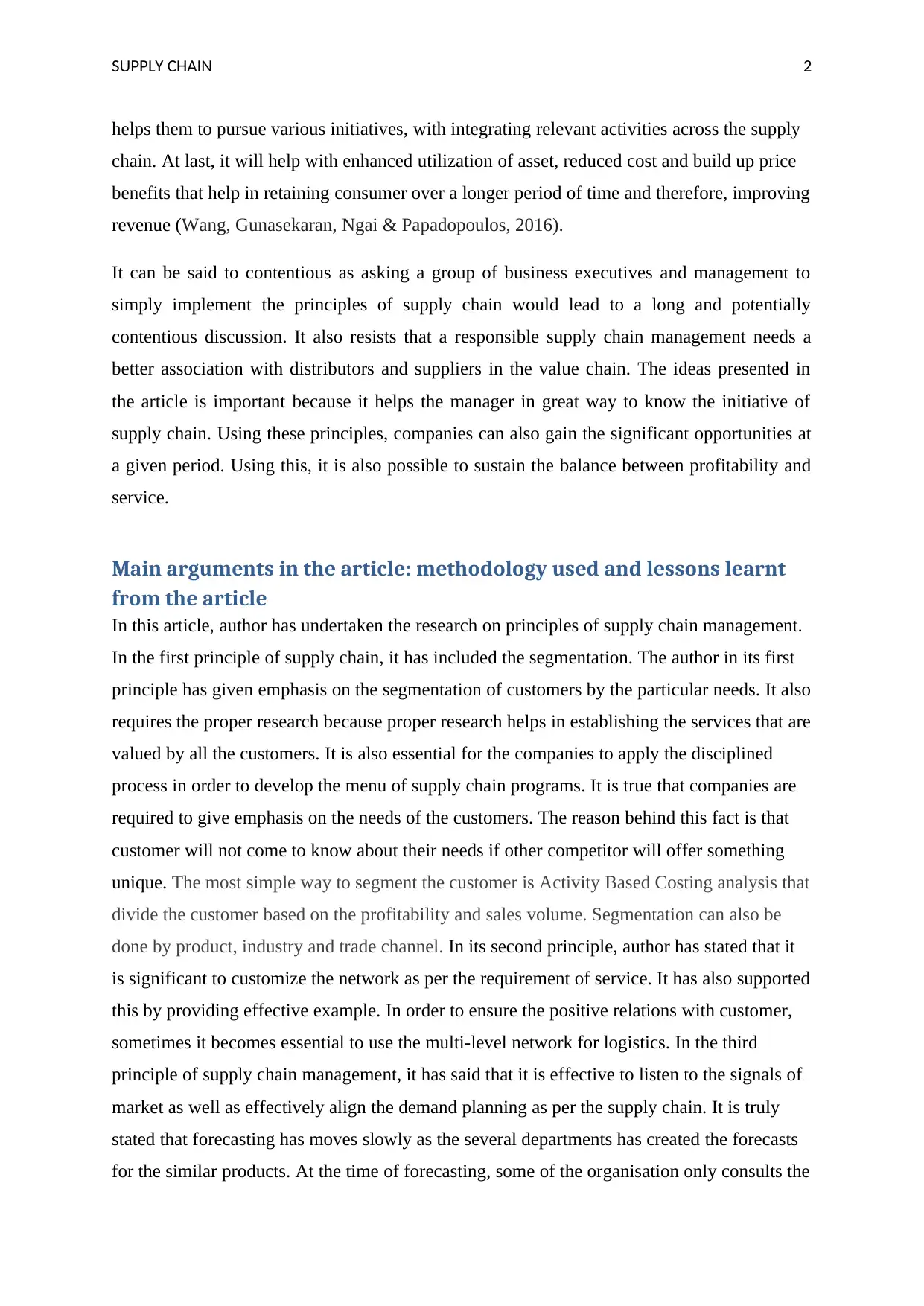
SUPPLY CHAIN 2
helps them to pursue various initiatives, with integrating relevant activities across the supply
chain. At last, it will help with enhanced utilization of asset, reduced cost and build up price
benefits that help in retaining consumer over a longer period of time and therefore, improving
revenue (Wang, Gunasekaran, Ngai & Papadopoulos, 2016).
It can be said to contentious as asking a group of business executives and management to
simply implement the principles of supply chain would lead to a long and potentially
contentious discussion. It also resists that a responsible supply chain management needs a
better association with distributors and suppliers in the value chain. The ideas presented in
the article is important because it helps the manager in great way to know the initiative of
supply chain. Using these principles, companies can also gain the significant opportunities at
a given period. Using this, it is also possible to sustain the balance between profitability and
service.
Main arguments in the article: methodology used and lessons learnt
from the article
In this article, author has undertaken the research on principles of supply chain management.
In the first principle of supply chain, it has included the segmentation. The author in its first
principle has given emphasis on the segmentation of customers by the particular needs. It also
requires the proper research because proper research helps in establishing the services that are
valued by all the customers. It is also essential for the companies to apply the disciplined
process in order to develop the menu of supply chain programs. It is true that companies are
required to give emphasis on the needs of the customers. The reason behind this fact is that
customer will not come to know about their needs if other competitor will offer something
unique. The most simple way to segment the customer is Activity Based Costing analysis that
divide the customer based on the profitability and sales volume. Segmentation can also be
done by product, industry and trade channel. In its second principle, author has stated that it
is significant to customize the network as per the requirement of service. It has also supported
this by providing effective example. In order to ensure the positive relations with customer,
sometimes it becomes essential to use the multi-level network for logistics. In the third
principle of supply chain management, it has said that it is effective to listen to the signals of
market as well as effectively align the demand planning as per the supply chain. It is truly
stated that forecasting has moves slowly as the several departments has created the forecasts
for the similar products. At the time of forecasting, some of the organisation only consults the
helps them to pursue various initiatives, with integrating relevant activities across the supply
chain. At last, it will help with enhanced utilization of asset, reduced cost and build up price
benefits that help in retaining consumer over a longer period of time and therefore, improving
revenue (Wang, Gunasekaran, Ngai & Papadopoulos, 2016).
It can be said to contentious as asking a group of business executives and management to
simply implement the principles of supply chain would lead to a long and potentially
contentious discussion. It also resists that a responsible supply chain management needs a
better association with distributors and suppliers in the value chain. The ideas presented in
the article is important because it helps the manager in great way to know the initiative of
supply chain. Using these principles, companies can also gain the significant opportunities at
a given period. Using this, it is also possible to sustain the balance between profitability and
service.
Main arguments in the article: methodology used and lessons learnt
from the article
In this article, author has undertaken the research on principles of supply chain management.
In the first principle of supply chain, it has included the segmentation. The author in its first
principle has given emphasis on the segmentation of customers by the particular needs. It also
requires the proper research because proper research helps in establishing the services that are
valued by all the customers. It is also essential for the companies to apply the disciplined
process in order to develop the menu of supply chain programs. It is true that companies are
required to give emphasis on the needs of the customers. The reason behind this fact is that
customer will not come to know about their needs if other competitor will offer something
unique. The most simple way to segment the customer is Activity Based Costing analysis that
divide the customer based on the profitability and sales volume. Segmentation can also be
done by product, industry and trade channel. In its second principle, author has stated that it
is significant to customize the network as per the requirement of service. It has also supported
this by providing effective example. In order to ensure the positive relations with customer,
sometimes it becomes essential to use the multi-level network for logistics. In the third
principle of supply chain management, it has said that it is effective to listen to the signals of
market as well as effectively align the demand planning as per the supply chain. It is truly
stated that forecasting has moves slowly as the several departments has created the forecasts
for the similar products. At the time of forecasting, some of the organisation only consults the
⊘ This is a preview!⊘
Do you want full access?
Subscribe today to unlock all pages.

Trusted by 1+ million students worldwide
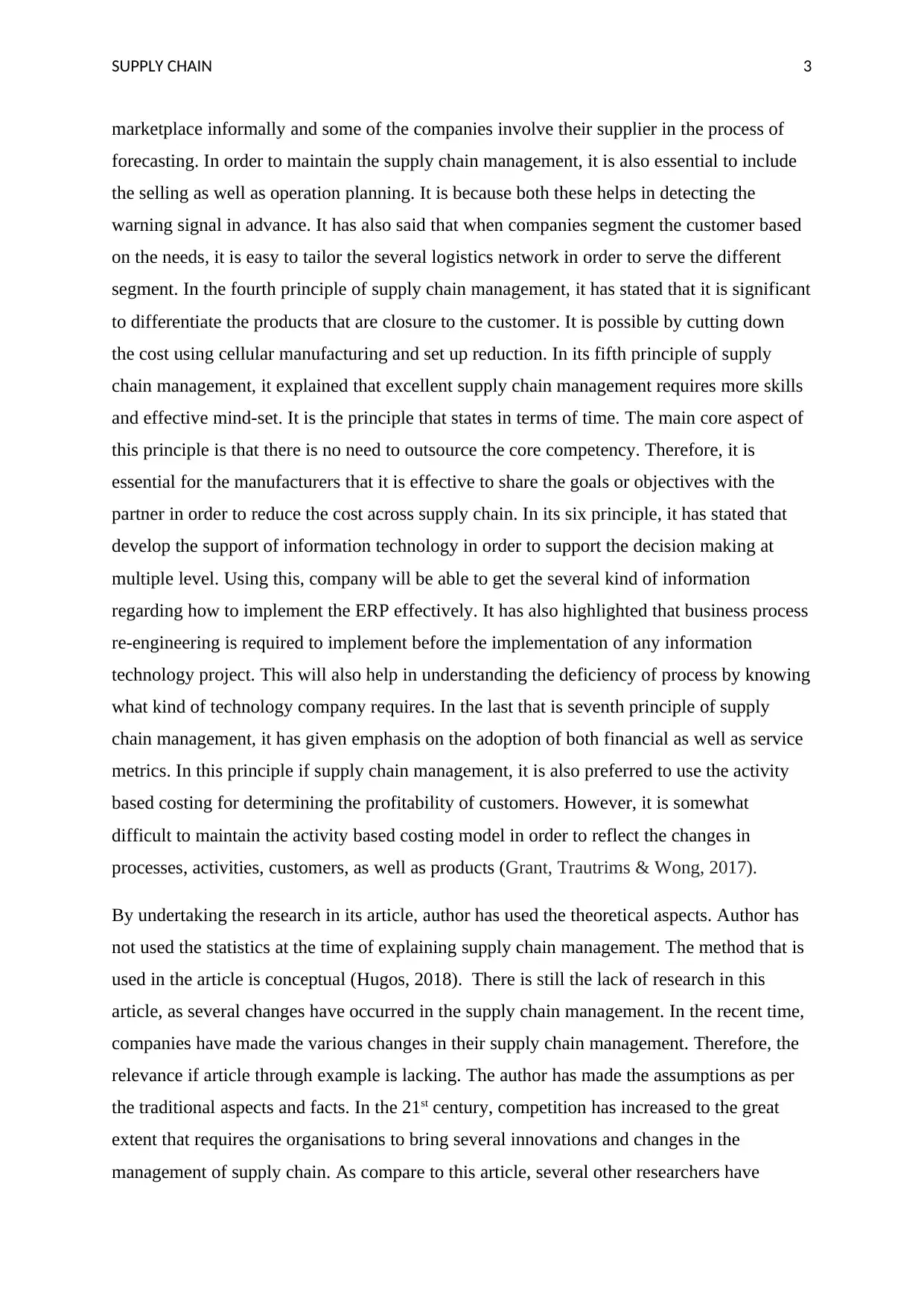
SUPPLY CHAIN 3
marketplace informally and some of the companies involve their supplier in the process of
forecasting. In order to maintain the supply chain management, it is also essential to include
the selling as well as operation planning. It is because both these helps in detecting the
warning signal in advance. It has also said that when companies segment the customer based
on the needs, it is easy to tailor the several logistics network in order to serve the different
segment. In the fourth principle of supply chain management, it has stated that it is significant
to differentiate the products that are closure to the customer. It is possible by cutting down
the cost using cellular manufacturing and set up reduction. In its fifth principle of supply
chain management, it explained that excellent supply chain management requires more skills
and effective mind-set. It is the principle that states in terms of time. The main core aspect of
this principle is that there is no need to outsource the core competency. Therefore, it is
essential for the manufacturers that it is effective to share the goals or objectives with the
partner in order to reduce the cost across supply chain. In its six principle, it has stated that
develop the support of information technology in order to support the decision making at
multiple level. Using this, company will be able to get the several kind of information
regarding how to implement the ERP effectively. It has also highlighted that business process
re-engineering is required to implement before the implementation of any information
technology project. This will also help in understanding the deficiency of process by knowing
what kind of technology company requires. In the last that is seventh principle of supply
chain management, it has given emphasis on the adoption of both financial as well as service
metrics. In this principle if supply chain management, it is also preferred to use the activity
based costing for determining the profitability of customers. However, it is somewhat
difficult to maintain the activity based costing model in order to reflect the changes in
processes, activities, customers, as well as products (Grant, Trautrims & Wong, 2017).
By undertaking the research in its article, author has used the theoretical aspects. Author has
not used the statistics at the time of explaining supply chain management. The method that is
used in the article is conceptual (Hugos, 2018). There is still the lack of research in this
article, as several changes have occurred in the supply chain management. In the recent time,
companies have made the various changes in their supply chain management. Therefore, the
relevance if article through example is lacking. The author has made the assumptions as per
the traditional aspects and facts. In the 21st century, competition has increased to the great
extent that requires the organisations to bring several innovations and changes in the
management of supply chain. As compare to this article, several other researchers have
marketplace informally and some of the companies involve their supplier in the process of
forecasting. In order to maintain the supply chain management, it is also essential to include
the selling as well as operation planning. It is because both these helps in detecting the
warning signal in advance. It has also said that when companies segment the customer based
on the needs, it is easy to tailor the several logistics network in order to serve the different
segment. In the fourth principle of supply chain management, it has stated that it is significant
to differentiate the products that are closure to the customer. It is possible by cutting down
the cost using cellular manufacturing and set up reduction. In its fifth principle of supply
chain management, it explained that excellent supply chain management requires more skills
and effective mind-set. It is the principle that states in terms of time. The main core aspect of
this principle is that there is no need to outsource the core competency. Therefore, it is
essential for the manufacturers that it is effective to share the goals or objectives with the
partner in order to reduce the cost across supply chain. In its six principle, it has stated that
develop the support of information technology in order to support the decision making at
multiple level. Using this, company will be able to get the several kind of information
regarding how to implement the ERP effectively. It has also highlighted that business process
re-engineering is required to implement before the implementation of any information
technology project. This will also help in understanding the deficiency of process by knowing
what kind of technology company requires. In the last that is seventh principle of supply
chain management, it has given emphasis on the adoption of both financial as well as service
metrics. In this principle if supply chain management, it is also preferred to use the activity
based costing for determining the profitability of customers. However, it is somewhat
difficult to maintain the activity based costing model in order to reflect the changes in
processes, activities, customers, as well as products (Grant, Trautrims & Wong, 2017).
By undertaking the research in its article, author has used the theoretical aspects. Author has
not used the statistics at the time of explaining supply chain management. The method that is
used in the article is conceptual (Hugos, 2018). There is still the lack of research in this
article, as several changes have occurred in the supply chain management. In the recent time,
companies have made the various changes in their supply chain management. Therefore, the
relevance if article through example is lacking. The author has made the assumptions as per
the traditional aspects and facts. In the 21st century, competition has increased to the great
extent that requires the organisations to bring several innovations and changes in the
management of supply chain. As compare to this article, several other researchers have
Paraphrase This Document
Need a fresh take? Get an instant paraphrase of this document with our AI Paraphraser
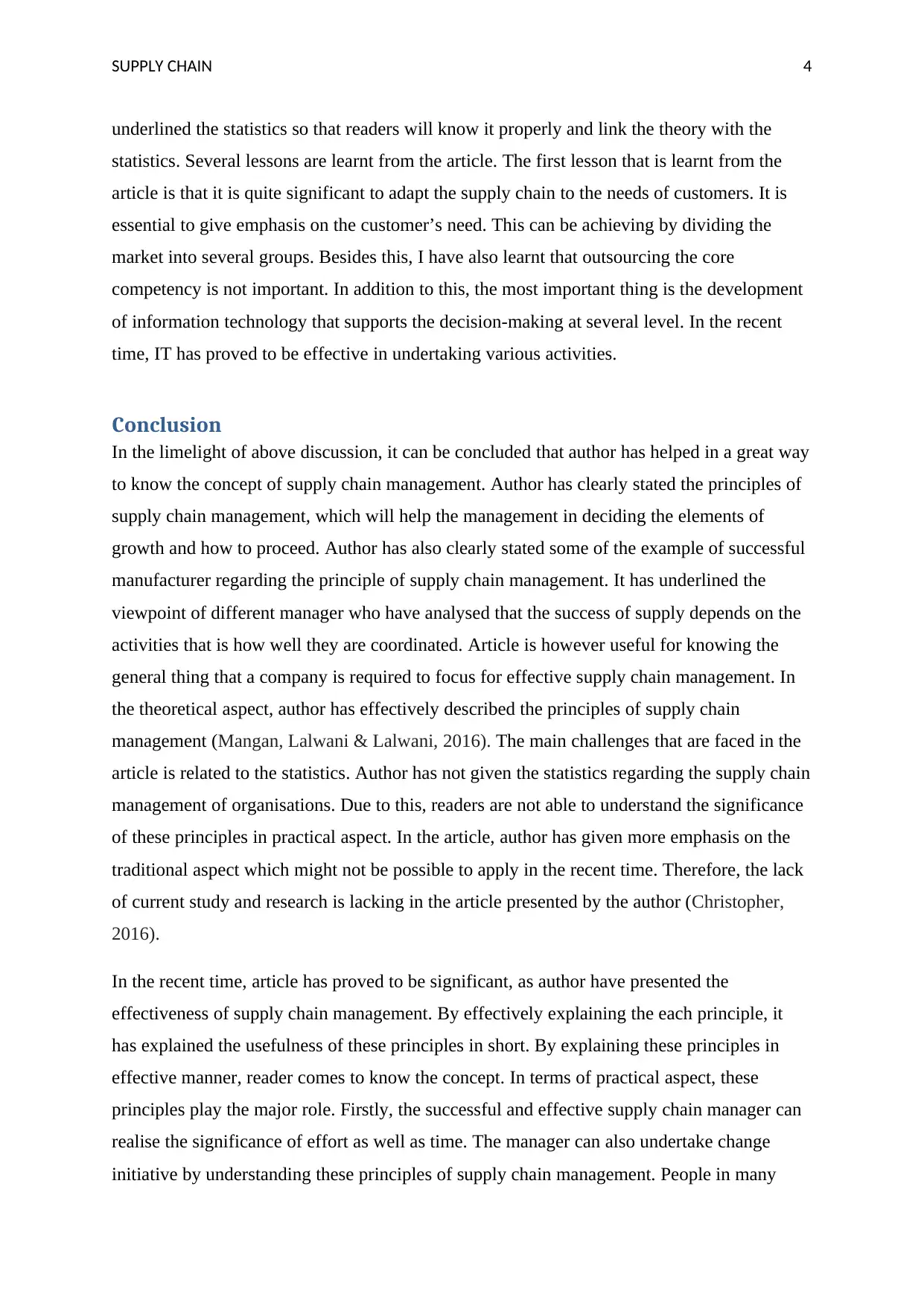
SUPPLY CHAIN 4
underlined the statistics so that readers will know it properly and link the theory with the
statistics. Several lessons are learnt from the article. The first lesson that is learnt from the
article is that it is quite significant to adapt the supply chain to the needs of customers. It is
essential to give emphasis on the customer’s need. This can be achieving by dividing the
market into several groups. Besides this, I have also learnt that outsourcing the core
competency is not important. In addition to this, the most important thing is the development
of information technology that supports the decision-making at several level. In the recent
time, IT has proved to be effective in undertaking various activities.
Conclusion
In the limelight of above discussion, it can be concluded that author has helped in a great way
to know the concept of supply chain management. Author has clearly stated the principles of
supply chain management, which will help the management in deciding the elements of
growth and how to proceed. Author has also clearly stated some of the example of successful
manufacturer regarding the principle of supply chain management. It has underlined the
viewpoint of different manager who have analysed that the success of supply depends on the
activities that is how well they are coordinated. Article is however useful for knowing the
general thing that a company is required to focus for effective supply chain management. In
the theoretical aspect, author has effectively described the principles of supply chain
management (Mangan, Lalwani & Lalwani, 2016). The main challenges that are faced in the
article is related to the statistics. Author has not given the statistics regarding the supply chain
management of organisations. Due to this, readers are not able to understand the significance
of these principles in practical aspect. In the article, author has given more emphasis on the
traditional aspect which might not be possible to apply in the recent time. Therefore, the lack
of current study and research is lacking in the article presented by the author (Christopher,
2016).
In the recent time, article has proved to be significant, as author have presented the
effectiveness of supply chain management. By effectively explaining the each principle, it
has explained the usefulness of these principles in short. By explaining these principles in
effective manner, reader comes to know the concept. In terms of practical aspect, these
principles play the major role. Firstly, the successful and effective supply chain manager can
realise the significance of effort as well as time. The manager can also undertake change
initiative by understanding these principles of supply chain management. People in many
underlined the statistics so that readers will know it properly and link the theory with the
statistics. Several lessons are learnt from the article. The first lesson that is learnt from the
article is that it is quite significant to adapt the supply chain to the needs of customers. It is
essential to give emphasis on the customer’s need. This can be achieving by dividing the
market into several groups. Besides this, I have also learnt that outsourcing the core
competency is not important. In addition to this, the most important thing is the development
of information technology that supports the decision-making at several level. In the recent
time, IT has proved to be effective in undertaking various activities.
Conclusion
In the limelight of above discussion, it can be concluded that author has helped in a great way
to know the concept of supply chain management. Author has clearly stated the principles of
supply chain management, which will help the management in deciding the elements of
growth and how to proceed. Author has also clearly stated some of the example of successful
manufacturer regarding the principle of supply chain management. It has underlined the
viewpoint of different manager who have analysed that the success of supply depends on the
activities that is how well they are coordinated. Article is however useful for knowing the
general thing that a company is required to focus for effective supply chain management. In
the theoretical aspect, author has effectively described the principles of supply chain
management (Mangan, Lalwani & Lalwani, 2016). The main challenges that are faced in the
article is related to the statistics. Author has not given the statistics regarding the supply chain
management of organisations. Due to this, readers are not able to understand the significance
of these principles in practical aspect. In the article, author has given more emphasis on the
traditional aspect which might not be possible to apply in the recent time. Therefore, the lack
of current study and research is lacking in the article presented by the author (Christopher,
2016).
In the recent time, article has proved to be significant, as author have presented the
effectiveness of supply chain management. By effectively explaining the each principle, it
has explained the usefulness of these principles in short. By explaining these principles in
effective manner, reader comes to know the concept. In terms of practical aspect, these
principles play the major role. Firstly, the successful and effective supply chain manager can
realise the significance of effort as well as time. The manager can also undertake change
initiative by understanding these principles of supply chain management. People in many
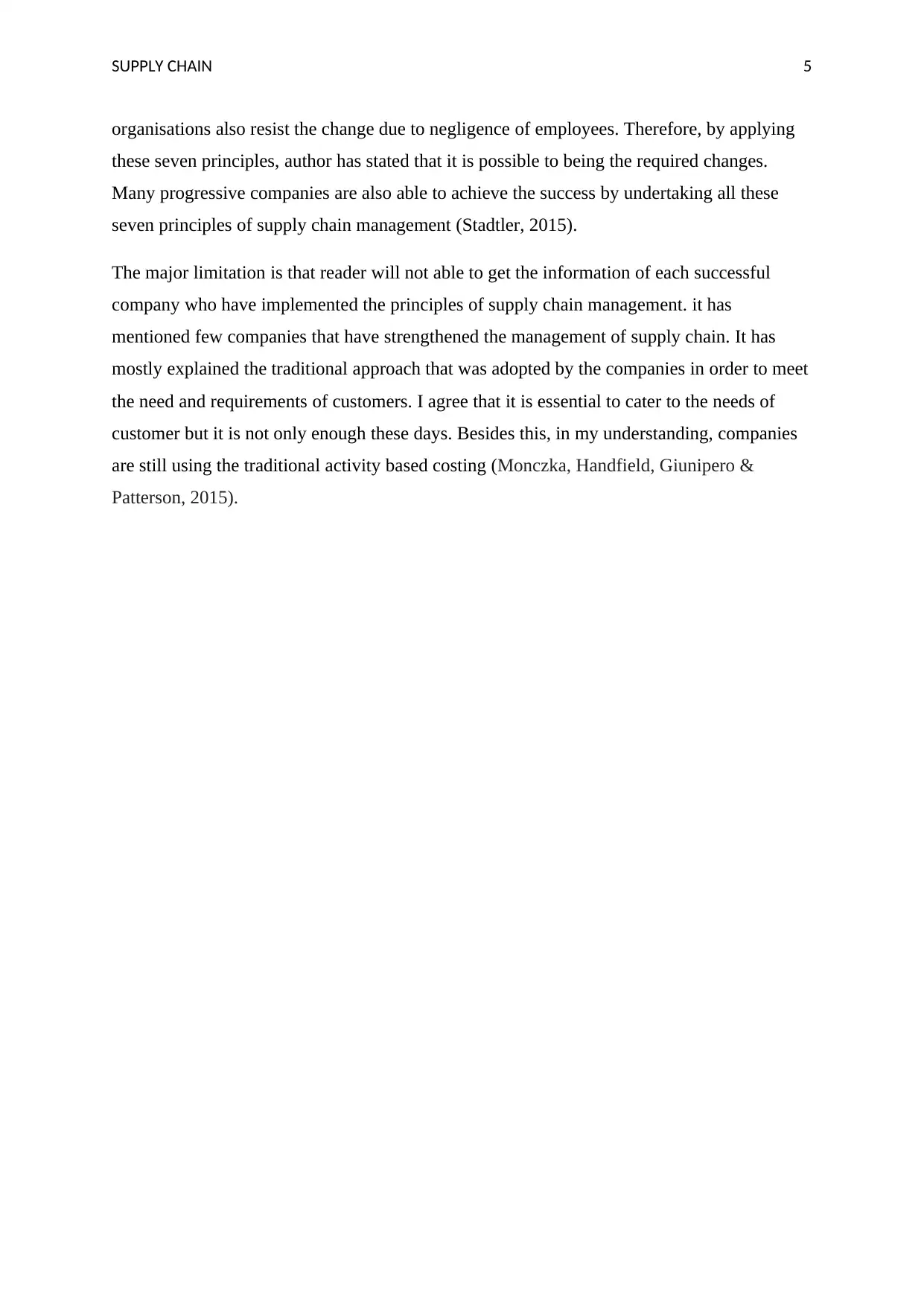
SUPPLY CHAIN 5
organisations also resist the change due to negligence of employees. Therefore, by applying
these seven principles, author has stated that it is possible to being the required changes.
Many progressive companies are also able to achieve the success by undertaking all these
seven principles of supply chain management (Stadtler, 2015).
The major limitation is that reader will not able to get the information of each successful
company who have implemented the principles of supply chain management. it has
mentioned few companies that have strengthened the management of supply chain. It has
mostly explained the traditional approach that was adopted by the companies in order to meet
the need and requirements of customers. I agree that it is essential to cater to the needs of
customer but it is not only enough these days. Besides this, in my understanding, companies
are still using the traditional activity based costing (Monczka, Handfield, Giunipero &
Patterson, 2015).
organisations also resist the change due to negligence of employees. Therefore, by applying
these seven principles, author has stated that it is possible to being the required changes.
Many progressive companies are also able to achieve the success by undertaking all these
seven principles of supply chain management (Stadtler, 2015).
The major limitation is that reader will not able to get the information of each successful
company who have implemented the principles of supply chain management. it has
mentioned few companies that have strengthened the management of supply chain. It has
mostly explained the traditional approach that was adopted by the companies in order to meet
the need and requirements of customers. I agree that it is essential to cater to the needs of
customer but it is not only enough these days. Besides this, in my understanding, companies
are still using the traditional activity based costing (Monczka, Handfield, Giunipero &
Patterson, 2015).
⊘ This is a preview!⊘
Do you want full access?
Subscribe today to unlock all pages.

Trusted by 1+ million students worldwide
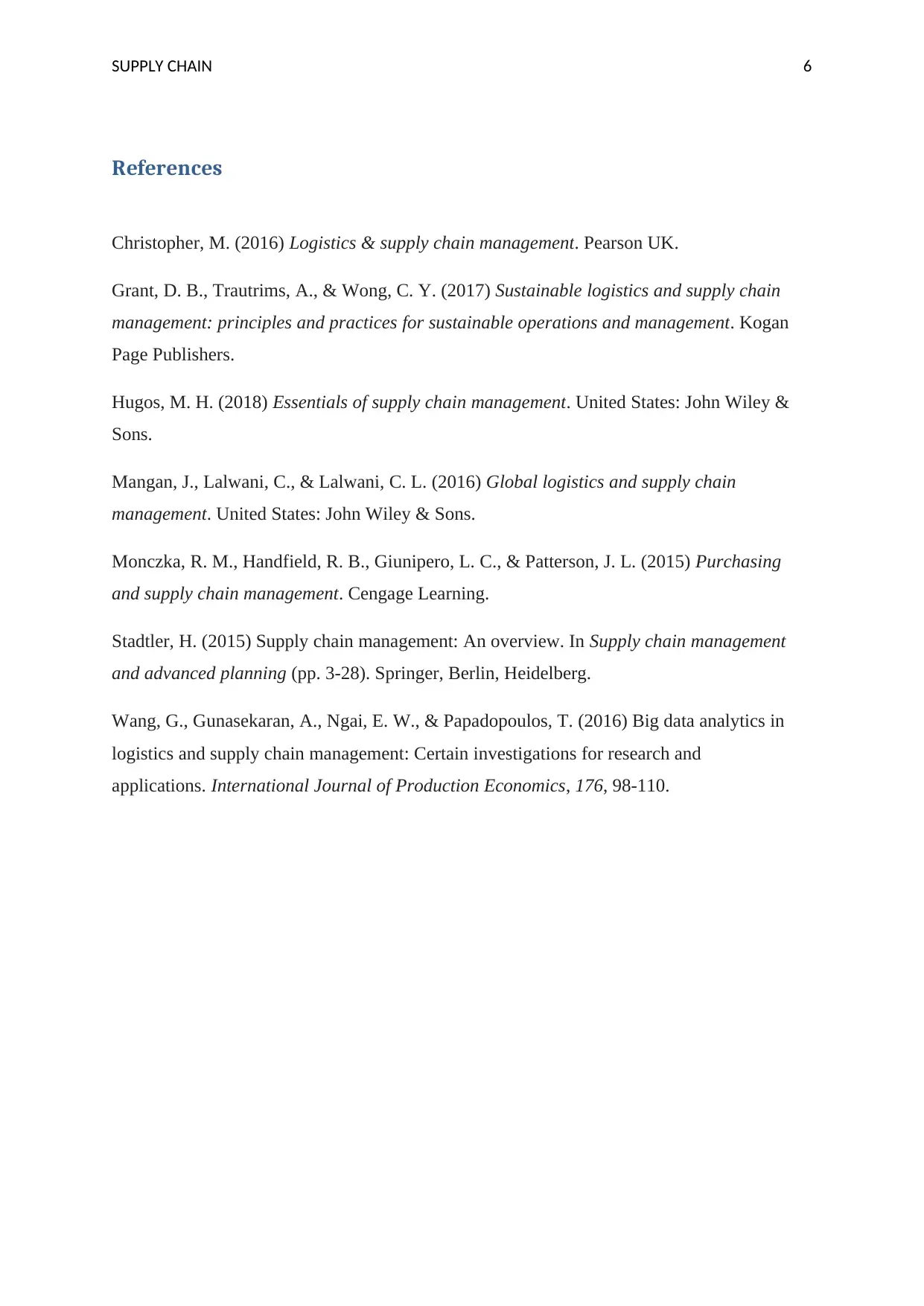
SUPPLY CHAIN 6
References
Christopher, M. (2016) Logistics & supply chain management. Pearson UK.
Grant, D. B., Trautrims, A., & Wong, C. Y. (2017) Sustainable logistics and supply chain
management: principles and practices for sustainable operations and management. Kogan
Page Publishers.
Hugos, M. H. (2018) Essentials of supply chain management. United States: John Wiley &
Sons.
Mangan, J., Lalwani, C., & Lalwani, C. L. (2016) Global logistics and supply chain
management. United States: John Wiley & Sons.
Monczka, R. M., Handfield, R. B., Giunipero, L. C., & Patterson, J. L. (2015) Purchasing
and supply chain management. Cengage Learning.
Stadtler, H. (2015) Supply chain management: An overview. In Supply chain management
and advanced planning (pp. 3-28). Springer, Berlin, Heidelberg.
Wang, G., Gunasekaran, A., Ngai, E. W., & Papadopoulos, T. (2016) Big data analytics in
logistics and supply chain management: Certain investigations for research and
applications. International Journal of Production Economics, 176, 98-110.
References
Christopher, M. (2016) Logistics & supply chain management. Pearson UK.
Grant, D. B., Trautrims, A., & Wong, C. Y. (2017) Sustainable logistics and supply chain
management: principles and practices for sustainable operations and management. Kogan
Page Publishers.
Hugos, M. H. (2018) Essentials of supply chain management. United States: John Wiley &
Sons.
Mangan, J., Lalwani, C., & Lalwani, C. L. (2016) Global logistics and supply chain
management. United States: John Wiley & Sons.
Monczka, R. M., Handfield, R. B., Giunipero, L. C., & Patterson, J. L. (2015) Purchasing
and supply chain management. Cengage Learning.
Stadtler, H. (2015) Supply chain management: An overview. In Supply chain management
and advanced planning (pp. 3-28). Springer, Berlin, Heidelberg.
Wang, G., Gunasekaran, A., Ngai, E. W., & Papadopoulos, T. (2016) Big data analytics in
logistics and supply chain management: Certain investigations for research and
applications. International Journal of Production Economics, 176, 98-110.
1 out of 7
Related Documents
Your All-in-One AI-Powered Toolkit for Academic Success.
+13062052269
info@desklib.com
Available 24*7 on WhatsApp / Email
![[object Object]](/_next/static/media/star-bottom.7253800d.svg)
Unlock your academic potential
Copyright © 2020–2025 A2Z Services. All Rights Reserved. Developed and managed by ZUCOL.




